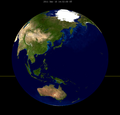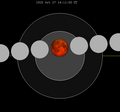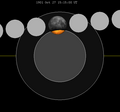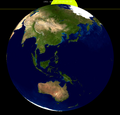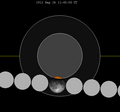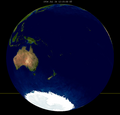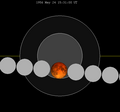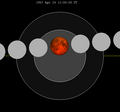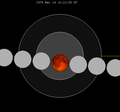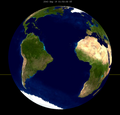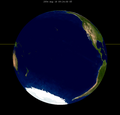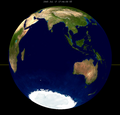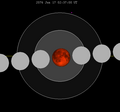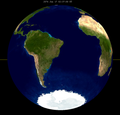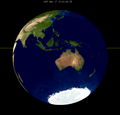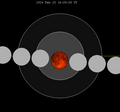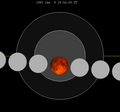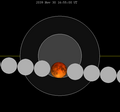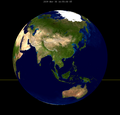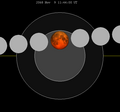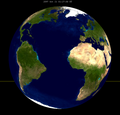December 2010 lunar eclipse
A total lunar eclipse occurred at the Moon’s descending node of orbit on Tuesday, December 21, 2010,[1] with an umbral magnitude of 1.2576. A lunar eclipse occurs when the Moon moves into the Earth's shadow, causing the Moon to be darkened. A total lunar eclipse occurs when the Moon's near side entirely passes into the Earth's umbral shadow. Unlike a solar eclipse, which can only be viewed from a relatively small area of the world, a lunar eclipse may be viewed from anywhere on the night side of Earth. A total lunar eclipse can last up to nearly two hours, while a total solar eclipse lasts only a few minutes at any given place, because the Moon's shadow is smaller. Occurring about 4 days before apogee (on December 25, 2010, at 7:15 UTC), the Moon's apparent diameter was smaller.[2] This eclipse was notable in that it coincided with the date of the Winter solstice in the Northern Hemisphere and Summer solstice in the Southern Hemisphere. It was the first total lunar eclipse to occur on the day of the Northern Winter Solstice (Southern Summer Solstice) since 1638, and only the second in the Common Era.[3][4] VisibilityThe eclipse was completely visible over North America and the eastern Pacific Ocean, seen rising over east Asia and Australia and setting over South America, west Africa, and Europe.[5]
Images
 Gallery
Individual shots, sorted by time:
Animations:
TimingIn North America, the eclipse was visible in its entirety on 21 December 2010, from 12:27 a.m. to 6:06 a.m. Eastern Standard Time.[7] In the Central Standard Time zone and west, the eclipse began the night of 20 December.[8] Observers along South America's east coast missed the late stages of the eclipse because they occurred after moon-set.[9] Likewise much of Europe and Africa experienced moon-set while the eclipse was in progress. In Europe, only those observers in northern Scandinavia (including Iceland), Ireland and Britain could observe the entire event. For observers in eastern Asia the moon rose in eclipse. The eclipse was not visible from southern and eastern Africa, the Middle East or South Asia. In Japan and northeastern Asia, the eclipse's end was visible, with the moon rising at sunset. In the Philippines it was observable as a partial lunar eclipse just after sunset.[9] Predictions suggested that the total eclipse may appear unusually orange or red, as a result of the eruption of Mount Merapi in Indonesia on 26 October.[10]
Eclipse detailsShown below is a table displaying details about this particular solar eclipse. It describes various parameters pertaining to this eclipse.[11]
Eclipse seasonThis eclipse is part of an eclipse season, a period, roughly every six months, when eclipses occur. Only two (or occasionally three) eclipse seasons occur each year, and each season lasts about 35 days and repeats just short of six months (173 days) later; thus two full eclipse seasons always occur each year. Either two or three eclipses happen each eclipse season. In the sequence below, each eclipse is separated by a fortnight.
Related eclipsesEclipses in 2010
Metonic
Tzolkinex
Half-Saros
Tritos
Lunar Saros 125
Inex
Triad
Lunar eclipses of 2009–2013This eclipse is a member of a semester series. An eclipse in a semester series of lunar eclipses repeats approximately every 177 days and 4 hours (a semester) at alternating nodes of the Moon's orbit.[12] The penumbral lunar eclipses on February 9, 2009 and August 6, 2009 occur in the previous lunar year eclipse set, and the lunar eclipses on April 25, 2013 (partial) and October 18, 2013 (penumbral) occur in the next lunar year eclipse set.
Metonic seriesThe Metonic cycle repeats nearly exactly every 19 years and represents a Saros cycle plus one lunar year. Because it occurs on the same calendar date, the Earth's shadow will be in nearly the same location relative to the background stars.
Saros 125This eclipse is a part of Saros series 125, repeating every 18 years, 11 days, and containing 72 events. The series started with a penumbral lunar eclipse on July 17, 1163. It contains partial eclipses from January 17, 1470 through June 6, 1686; total eclipses from June 17, 1704 through March 19, 2155; and a second set of partial eclipses from March 29, 2173 through June 25, 2317. The series ends at member 72 as a penumbral eclipse on September 9, 2443. The longest duration of totality was produced by member 37 at 100 minutes, 23 seconds on August 22, 1812. All eclipses in this series occur at the Moon’s descending node of orbit.[13]
Eclipses are tabulated in three columns; every third eclipse in the same column is one exeligmos apart, so they all cast shadows over approximately the same parts of the Earth.
Tritos seriesThis eclipse is a part of a tritos cycle, repeating at alternating nodes every 135 synodic months (≈ 3986.63 days, or 11 years minus 1 month). Their appearance and longitude are irregular due to a lack of synchronization with the anomalistic month (period of perigee), but groupings of 3 tritos cycles (≈ 33 years minus 3 months) come close (≈ 434.044 anomalistic months), so eclipses are similar in these groupings.
Inex seriesThis eclipse is a part of the long period inex cycle, repeating at alternating nodes, every 358 synodic months (≈ 10,571.95 days, or 29 years minus 20 days). Their appearance and longitude are irregular due to a lack of synchronization with the anomalistic month (period of perigee). However, groupings of 3 inex cycles (≈ 87 years minus 2 months) comes close (≈ 1,151.02 anomalistic months), so eclipses are similar in these groupings.
Half-Saros cycleA lunar eclipse will be preceded and followed by solar eclipses by 9 years and 5.5 days (a half saros).[15] This lunar eclipse is related to two annular solar eclipses of Solar Saros 132.
See also
Notes
External linksWikimedia Commons has media related to Lunar eclipse of 2010 December 21.
|
||||||||||||||||||||||||||||||||||||||||||||||||||||||||||||||||||||||||||||||||||||||||||||||||||||||||||||||||||||||||||||||||||||||||||||||||||||||||||||||||||||||||||||||||||||||||||||||||||||||||||||||||||||||||||||||||||||||||||||||||||||||||||||||||||||||||||||||||||||||||||||||||||||||||||||||||||||||||||||||||||||||||||||||||||||||||||||||||||||||||||||||||||||||||||||||||||||||||||||||||||||||||||||||||||||||||||||||||||||||||||||||||||||||||||||||||||||||||||||||||||||||||||||||||||||||||||||||||||||||||||||||||||||||||||||||||||||||||||||||||||||||||||||||||||||||||||||||||||||||||||||||||||||||||||||||||
Portal di Ensiklopedia Dunia
















![From Seattle, Washington, beginning of totality, 7:41 UTC[6]](http://upload.wikimedia.org/wikipedia/commons/thumb/c/cc/Lunar_Eclipse_seen_from_Seattle_21-12-2010.jpg/120px-Lunar_Eclipse_seen_from_Seattle_21-12-2010.jpg)





























